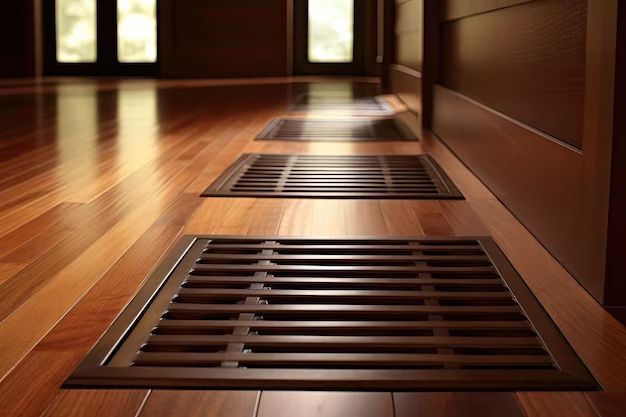Page Contents
Quick Answer
Floor vents can be covered, but it’s generally not recommended. Covering floor vents can restrict airflow and potentially cause problems with heating, cooling, and indoor air quality. There are some scenarios where covering floor vents may be acceptable or even necessary, but it should be done carefully and selectively.
Should You Cover Floor Vents?
There are a few reasons why you may want to cover floor vents:
- Improve energy efficiency – Covering vents in unused rooms may help reduce energy costs by not heating or cooling those spaces.
- Block drafts – Covering vents near seating areas or beds can help prevent uncomfortable direct drafts.
- Protect children/pets – Covering vents can prevent fingers, paws, etc. from getting caught in the vent.
- Reduce noise – Covering vents can dampen noise from the HVAC system.
- Improve appearance – Floor vents may be considered unsightly.
However, there are also some potential downsides to covering vents:
- Restricted airflow – Covering too many vents can restrict overall airflow, reducing heating/cooling efficiency.
- Imbalanced airflow – Blocking vents room by room can imbalance the HVAC system airflow.
- Increased dust/allergens – Restricted airflow allows more dust and allergens to accumulate.
- Moisture buildup – Covering vents can lead to excess moisture in unused rooms.
- Safety issues – Blocked vents can cause carbon monoxide or combustion byproducts to accumulate from furnaces, water heaters, etc.
So covering vents should be done sparingly and only after careful consideration. Never cover all vents as it can cause HVAC malfunction and indoor air quality issues.
Best Practices for Covering Vents
If you do need to cover floor vents, follow these guidelines:
- Only cover 1-2 vents per room max.
- Never cover all vents on a single HVAC zone.
- Avoid blocking vents near combustion appliances like furnaces and water heaters.
- Use removable magnetic or adhesive covers to allow adjustment.
- Ensure some airflow still enters covered rooms.
- Monitor humidity levels in rooms with covered vents.
- Make sure covers fit securely and will not be dislodged.
- Check that covers do not interfere with HVAC system operation.
- Remove covers if any moisture, odor, or comfort issues arise.
It’s also best to get professional HVAC advice before covering multiple vents. An HVAC technician can assess your system and make vent covering recommendations tailored to your specific home.
Types of Floor Vent Covers
If you do need to cover floor vents, there are a few different types of products available:
Magnetic Vent Covers
- Thin magnetic sheets adhere securely over vents.
- Allow airflow while damping noise and blocking drafts.
- Easy to remove for vent access or adjustment.
- Some have decorative fabric coverings.
- Available in many standard vent sizes.
Adhesive Vent Covers
- Self-adhesive vinyl or foam covers stick over vents.
- Help muffle noise and seal out drafts.
- Must be replaced once removed.
- Some may damage vent finish when removed.
Ventilation Boxes
- Plastic enclosures mount over floor vent.
- Adjustable baffles or dampers to control airflow.
- Let air in while blocking direct drafts.
- Often used in home theaters.
Solid Vent Covers
- Sturdy metal or plastic covers completely block vent.
- Only recommended for temporary use in unused rooms.
- Prevent air circulation so moisture can build up.
Carefully weigh the benefits and risks before selecting and installing any vent covers. Improper use can cause indoor air quality or HVAC problems.
Alternative Ways to Handle Floor Vent Issues
If you are having draft, noise, or appearance issues with floor vents, covering them may not be the only or best solution. Here are a few other options to consider:
- Adjust vent baffles – Most vents have adjustable baffles to redirect airflow. These can be closed to the minimum open position to reduce drafts.
- Install high-density vent filters – Multi-layer filters can help catch dust and allergens from vents.
- Use fans/air purifiers – Strategically placed fans and air purifiers can help circulate and filter air without closing vents.
- Install vent deflectors – Plastic deflectors mounted over vents direct air up across the ceiling instead of straight out.
- Relocate vents – In some cases, the HVAC system can be adjusted to move a vent to a less conspicuous location.
- Add vent covers/grilles – Decorative covers or grilles can make vents blend in while allowing airflow.
Professional HVAC contractors can help identify the best solutions for any specific floor vent issues you may have.
Key Takeaways
The key points on covering floor vents:
- Covering too many vents can cause HVAC problems and poor indoor air circulation.
- Only cover a few vents selectively, never all vents in a room or zone.
- Use removable magnetic or adhesive covers for adjustment ability.
- Monitor air quality and moisture in rooms with covered vents.
- Get professional HVAC advice before making vent changes.
- Consider alternative methods like vent deflectors to handle draft and appearance issues.
Covering floor vents requires caution. With careful selection and monitoring, covering one or two vents per room may be possible without issues. However, the safest approach is to generally keep floor vents unblocked.
Conclusion
Floor vents can be covered, but it’s generally best to avoid blocking vents except in a few selective cases. Blocking too many vents can lead to problems with indoor comfort and air quality as well as HVAC system efficiency and safety. Any vent covering should be done carefully and minimally. It’s always best to consult HVAC professionals before making adjustments to vent airflow. With the right advice and approach, covering some floor vent grilles can be done without issue, but unrestricted airflow should be maintained throughout the HVAC system. Considering alternative solutions can often address floor vent concerns like drafts and appearance without the need for coverings that restrict air circulation.
